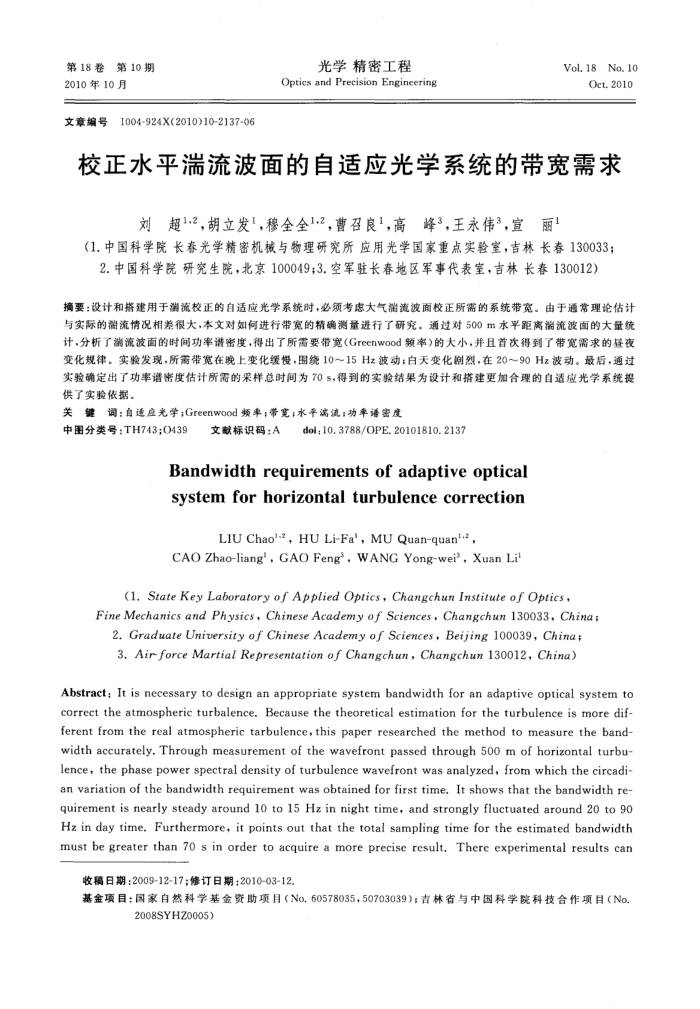内容简介
 第18卷
第18卷第10期
2010年10月
1004-924X(2010)10-2137-06
文章编号
光学精密工程
Optics and Precision Engineering
No. 10
Vol.18
Oct.2010
校正水平流波面的自适应光学系统的带宽需求
刘超12,胡立发1,穆全全12,曹召良,高峰3,王永伟3,宣丽1
(1.中国科学院长春光学精密机械与物理研究所应用光学国家重点实验室,吉林长春130033; 2.中国科学院研究生院,北京100049;3.空军驻长春地区军事代表室,吉林长春130012)
摘要:设计和搭建用于渊流校正的自适应光学系统时,必须考虑大气瑞流波面校正所需的系统带宽。由于通常理论估计与实际的淄流情况相差很大,本文对如何进行带宽的精确测量进行了研究。通过对500m水平距离端流波面的大量统计,分析了满流波面的时间功率谱密度,得出了所需要带宽(Greenwood频率)的大小,并且首次得到了带宽需求的登夜变化规律,实验发现,所需带宽在晚上变化缓慢,图绕10~15Hz波动;白天变化剧烈,在20~90Hz波动。最后,通过实验确定出了功率谱密度估计所需的采样总时间为70s,得到的实验结果为设计和搭建更加合理的自适应光学系统提供了实验依据。
关键词:自适应光学;Greenwood频率,带宽,水平漓流;功率语密度
中图分类号:TH743;O439
文献标识码:A
doi;10.3788/OPE.20101810.2137
Bandwidth requirements of adaptive optical systemforhorizontalturbulencecorrection
LIU Chaol-,HU Li-Fa',MU Quan-quan-2,
CAO Zhao-liang',GAOFeng,WANG Yong-wei',XuanLi
(1.StateKey Laboratory of Applied Optics,Changchun Instituteof Optics
FineMechanics and Physics,ChineseAcademyof Sciences,Changchun130033,China 2.GraduateUniversity of Chinese Academy of Sciences,Beijing 100039,China 3.Air-forceMartialRepresentationofChangchunChangchun130012,China)
Abstract: It is necessary to design an appropriate system bandwidth for an adaptive optical system to correct the atmospheric turbalence. Because the theoretical estimation for the turbulence is more dif-ferent from the real atmospheric tarbulence,this paper researched the method to measure the band-width accurately. Through measurement of the wavefront passed through 5oo m of horizontal turbu-lence, the phase power spectral density of turbulence wavefront was analyzed, from which the circadi-an variation of the bandwidth requirement was obtained for first time. It shows that the bandwidth re quirement is nearly steady around 10 to 15 Hz in night time, and strongly fluctuated around 20 to 90 Hz in day time. Furthermore, it points out that the total sampling time for the estimated bandwidth must be greater than 7o s in order to acquire a more precise result. There experimental results can
收稿日期:2009-12-17;修订日期:2010-03-12
基金项目:国家白然科学基金资助项目(No,60578035,50703039);吉林省与中国科学院科技合作项目(No.
2008SYHZ0005)
上一章:无遮拦折反射红外光学系统
下一章:鲁棒的基于改进Mean-shift的目标跟踪